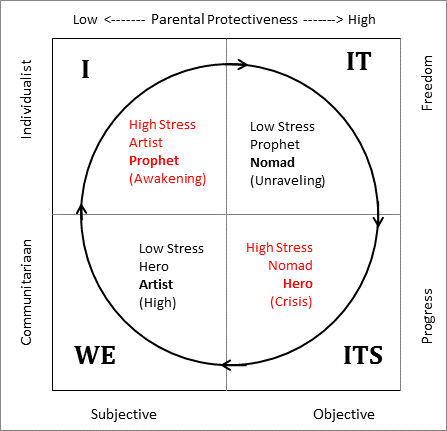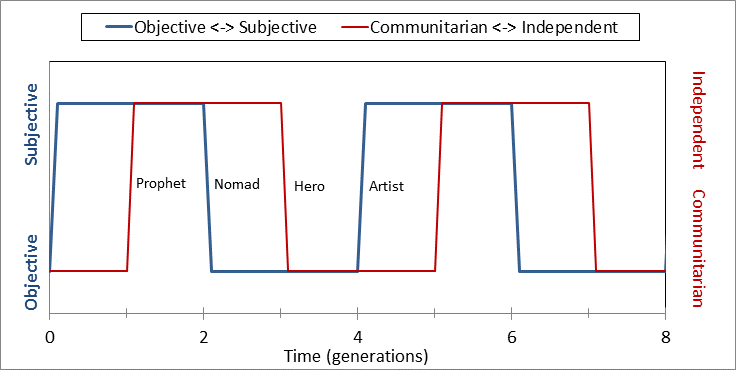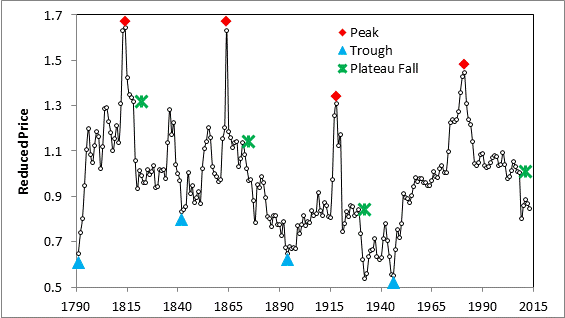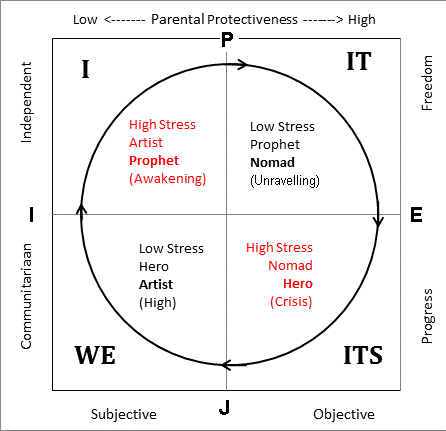I would like to submit that much of the discrepancy noted on this board between how the saeculum operated in the past and how it operates now can be solved by viewing essentially two different modes of saeculum at work, one morphing under stress into the other during the early modern period. I call these modes Saeculum I and Saeculum II.
Some of the discrepancies/issues that have been noted are:
A) 27-year versus 22 (or even 17) year generations with subsequent generational/turning compaction.
B) The enormous age of ?fourth phase? elderhood generations in earlier saeculae and the resulting breakdown in Strauss & Howe?s tetralogical explanation of generational dynamics as one goes further back in time.
C) Nomad generation constituents playing Gray Champion roles as little as three saeculae ago.
A few weeks ago my mind was trying to wrap itself around a conundrum: I found myself to be an orthodox Strauss & Howe Saecularist but I could not square the problems delineated by Mike Alexander and others with said orthodoxy. The mechanism laid out in
Generations and
The Fourth Turning that works so well for the 20th century seems to wane in explanatory efficacy the further back one goes into history. Even Strauss & Howe do not recognize a consistent functioning of the saeculum prior to late 15th century (why that may be will explained later).
Statistically, it is as if the authors took a sizeable, yet decidedly partial, subset of history, found a pattern (and even then one that only performed excellently in yet a smaller subset), and declared the discovery of a fundamental historiographical paradigm. As a result, one could argue (and some critics have stated) that what Strauss & Howe discovered was not much more than (what statisticians would call) an ?accidental correlation?, at least before the last century is concerned. Yet their paradigm does seem to apply to patterns in pre-modernity. How does one rectify this?
I would like to offer an explanation: I call it informally ?Mike Alexander meets the Three-Phase Solution?, or more formally ?Saeculum I?.
Saeculum I
Mike has noted a 27-year generational pattern operating in (at least) pre-modern Europe. This is 5-10 years longer than more current generational lengths (depending upon who you read and how ?currently? you look in history). He also notes a pendular effect of demographically smaller and larger generations due to a directly related alteration between periods of famine and plenty. Going one step further, he also notes that the periods of high stress (famines) oscillate between types of critical stress (i.e., Social Moments), one secular and institutional, usually involving great wars, the other spiritual and personal, involving emotive awakenings, monastic enthusiasm, and rashes of heretical fervor.
If I understand Mike correctly (and I may not) he dismisses the possibility of a 27-year phase solution to harmonize his observations with Strauss & Howe?s basic mechanism. At first glance this makes sense since a 27-year ?pueritia? or childhood phase and an 81-107 year old elderhood phase are nonsensical.
But what if the saecular mechanism operating through most of history was not a four phase, tetralogical dynamic, but rather a three phase, trilogical one? --- an interaction of three archetypes at a time instead of four, yet still operating in four turnings/constellations?
What if a 27-year ?youth? phase could actually make sense? I propose that in pre-modern society this actually did work, if we define ?youth? as pre-autonomy. As Mr. Alexander points out, biological/demographic realities created a perfect format for generational division, and this division was a 27-year delineation. And in an average demographic snapshot one could easily see the biologically-familiar three generation scenario of a 13 year old child (mid-youth), two 40 year old parents (mid-maturity), and one or two 67 year old grandparents (mid-elderhood). And by the time the youth in this example hits 27, chances are all the grandparents are gone and he or she is in the middle of raising a new crop of youngsters. What?s more the youth?s parents are now biologically old (by pre-modern standards) and ready to pass the baton of fully-realized social maturity, what I will call ?Primacy?, to a new group.
In premodernity the extended family was the rule, not the nuclear family of today. One could easily see the mature fortysomething father still holding strong functional authority over physically mature but still socially inferior sons in their early-to-mid twenties. Furthermore there was little impetus to have the young men strike out on their own at physical maturity like today. Extended family-members relied closely on one another in pre-industrial times, often in the same household, especially in the more common non-urban setting.
If one takes a look at pre-modern and early modern societies, one sees that, though there were rites-of-passage marking physical maturation, these societies? young men did not share in full societal responsibility until much after puberty.
Jesus, for example, did not begin his ministry until he was 30. This has been attributed to ancient Hebrew society?s recognition of 30 years of age as when a man reached full social maturity. Jesus might have not been taken seriously if he tried much earlier. One can note that he began showing other aspects of maturity as early as 12, and the Hebrews, then and now, held a rite-of-passage about that age denoting the beginnings of physical maturity. Ancient Hebrews also considered a male to be of military age at 20. So, as now, there were stages of maturation, but full social acceptance as an autonomous adult came considerably later than today.
Strong vestiges of this higher pre-modern limit to recognized social maturity can also be seen in the Founding Fathers not allowing any one younger than 25 to enter the House of Representatives, and younger than 30 to enter the Senate.
Perhaps further research should be done on Strauss & Howe?s interpretation of the Romans? fourfold biological divisions. I would contend that in the saeculum as it often manifested in premodernity, the Romans? ?pueritia? and ?iuventus? are actually subsets of the same phase: Pre-autonomy (Youth).
If one accepts 27 year phases of life for pre-modern society and accepts that the four generational archetypes are a constant (and I believe they are) then the four turnings looked much like they do today except that one archetype is completely missing per turning.
Saeculum I and Phases of Life
Code:
Phase Ages
Elderhood 54-80
Primacy 27-53
Youth 0-26
Saeculum I and Turnings
Code:
Phase 1T 2T 3T 4T
Elderhood Hero Artist Prophet Nomad
Primacy Artist Prophet Nomad Hero
Youth Prophet Nomad Hero Artist
This new mechanism goes far in explaining much that is incongruent with the four phase model. Gone is the problem of 100 year old fourth phasers presumably affecting history. And in this arrangement, the tragic fall and passing of an elderly, hubristic Odyssean Hero-figure signals the beginning of an Awakening, not the peak or ending of one; likewise, the passing of an elderly, reproving, Jeremiadic Prophet-figure signals the beginning of a Crisis, not it?s climax or resolution.
What about the ?Shadow? mechanism described by Strauss & Howe? How do the generational archetypes affect one another and produce their archetypal shadow in a trilogical dynamic? Mike Alexander explains this in several posts. He posits a slightly different mechanism.
Mike Alexander in February 13, 2004 wrote:
During the social moment, the generation being born and growing up rebels against their elders by adopting the other outlook. Hence in a crisis spiritual Artists are born to secular Heros. Artists retain the communitarian ethic of their parents because this style is favored by the conditions of the Crisis, but Artists rebel during the High against the spirit-dead world created by their Hero parents and Nomad grandparents. On the other hand, secular Nomads are born to spiritual Prophets during the Awakening. Nomads retain the individualistic ethic of their parents as this style is favored by the conditions of the Awakening During the unraveling, Nomads rebel against their (too) spirit-filled elders by adopting a pragmatic, secular worldview. In my scheme, the "gray champions" of the crisis are Nomads.
This mechanism explains how Saeculum I manages to foster the four archetypes with three phases instead of four.
And indeed, as stated above one could argue that in the Early Modern period the Gray Champions were Nomads: Margaret of Anjou, Elizabeth I, Benjamin Church, George Washington. Using Michael Alexander?s mechanism this was probably the case in most Crises before modernity. But what of Strauss and Howe?s convincing argument of a mythic resonance through the ages of an elder Prophet- young Hero bond? What is more, what of the enduring images elder Hero-young Prophet conflict?
Saeculum II
This all begs the question, Why is Saeculum I no longer operating? First, it may actually still be operating in certain societies today (or at least until very recently) that still retain many pre-modern aspects (e.g., agricultural-based economy, poor nutrition, poor education, cyclical worldview, opposition to change). Indeed, it was the waning of these aspects and the advent of modern, and especially industrial, society that led to the shift to Saeculum II.
Part of my thesis is that under certain stress, saecular structures change mode, either temporarily, as possibly on occasion in the distant past, --- or structurally, as in modern times.
In pre-modernity the saeculum usually involved a 27-year generation due to the first phase of life being that length (as explained from Mike Alexander?s observations of the data). But around the 16th and 17th centuries forces came into play that began to alter the demarcation point between Youth and Primacy. First, with the Gutenberg Revolution, the Renaissance, Protestant Reformation, and other massive paradigm shifts (socio-cultural and techno-economic) of the early modern period, the pace of change increased to an unprecedented degree. Changes from generation to generation acted as a stressor on the 27-year-based mechanism that theretofore worked well for the relatively slow pace of change of pre-modernity. The quickened pace of life was more easily absorbed in a shorter cohort groupings therefore putting downward pressure on phase length.
Furthermore, by the 17th and 18th centuries the Famine Cycle had been (largely) allayed, further loosening the Youth phase from it?s solid 27-year mooring. From some of Mike Alexander?s other writings, one could speculate that the now less stable and pressured phases interacted in some way with the War/Debt Cycle of the time period.
Saeculum I was under stress. As the length of generations dropped by a couple of years, the permutational demarcation points between phases dropped. Soon the Youth-Primacy transition was below 25 years, Primacy to Elderhood below 50 years, and the vanguard age for Post-Elderhood was closing in on 70, allowing a ?Post-Elder? cohort group to begin affecting the saecular dynamic.
But it is with the Industrial Revolution that Saeculum I finally broke under the strain. At least four factors affected the final transition.
1. An evidentially exponential rate of change.
One could argue that the rate of change in human society has always been exponential. Only at this point, i.e., the advent of industrialization, it became much more obvious and relevant. As in the early modern period, this put additional pressure on the saecular mechanism to process change.
2. The beginning of ontogenic compaction (earlier pubescence) due to improved nutrition.
With agricultural production and variety increasing, with better transportation systems for delivery, and with higher average real purchasing power, improved nutrition in the 18th and 19th centuries (depending upon the Western country in question) began a trend continuing to this day of a younger and younger onset of physical maturity.
3. The beginning of psychogenic compaction (accelerated mental development) due to better and more comprehensive education.
This is the most controversial of the postulations. However, one could argue that improved childhood education stimulated certain mental capacities earlier and more profoundly. It is possible that the commencement of Piagetian ?concrete operations? and ?formal operations? may occur earlier (and more comprehensively) today on average than two or three centuries ago.
4. The earlier acquisition of social autonomy due to the above items, but especially because of the nuclearization of the family.
Migration to the cities, migration cross-country, less emphasis on acquired vocational skill and therefore parental mentoring in familial occupations, among other things led to the gradual breakdown in the cohesiveness and functionality overall of the traditional extended family and ushered in a new emphasis on the nuclear family. This transition largely weakened the firm hold middle-aged parents (read: father) had on young adult children. For this and other reasons stated above, full social autonomy would arrive years earlier than under the conditions Saeculum I evolved in.
Modal Shift
It is quite clear, at least in American history, that a great saecular upset occurred in the 19th century. For Strauss & Howe, this means the Civil War Anomaly. For Mike Alexander, this means a dramatic shortening of generation length. Within the context of the Multi-Modal Saeculum concept, both occurred. The combination created a Saecular hiccup, a shift from dissonance to a new equilibrium. What brought it to a climax was the vagaries of fate creating a Prophet generation (The Transcendentals) of regular length by the standards of the first saecular mode proper, but of dysfunctional length within the context of the saecular discord then occurring.
The result was the omission of an Hero archetype generation, truncated turnings and persistent saecular settling: No testaments to communitarian Olympian rationalizers, shortened fourth and first turnings, dilatory spiritualism extending into the following third turning, Nomads with Hero qualities (Gilded), Artists with Hero qualities (Progressive), and a subsequently somewhat archetypally-attenuated Prophet archetype (Missionary).
If we go by Mike Alexander?s observations, we can surmise that modal pressure became extreme around 1820. The following collapse of Saeculum I occurred in the 1860?s. And one could argue that it would not be until the following fourth turning that the saecular dynamic fully stabilized into its new mode.
What of other societies? In regards to the European saeculum, could this help explain the catastrophe of World War One? And what of industrializing societies today? This is especially germane when one considers China and the Middle East. Developing societies today are modernizing at a pace far greater than what the West experienced. What implications does this have for their modal transitions? What ?hiccups? may occur with them?
Finally, back to antiquity: How is it that Strauss and Howe found compelling evidence of a tetralogical interaction in such diverse sources as Exodus and Homer? And what of the profound Prophet-Hero interactions mentioned earlier? One explanation is that archetypal forms were mythographically distilled into a four part story since the generational archetypes, of which there are unavoidably four, are easier to convey that way.
Another explanation is that in times of profound stress or some other X factor, Saeculum I societies metamorphosed into a Saeculum II mode presaging the structural shift of recent times. However, whenever the stress or X factor passed, the saecular dynamic ?de-excited? and shifted back to the original mode (akin to an electron descending an atomic orbit after expending energy). Strauss and Howe attributed the fading of their tetralogical dynamic to when ?the inertia of tradition dampened this cycle and pushed society back to a prescribed and changeless role for each phase of life.?[
The Fourth Turning, p.90]. Since the authors do not recognize a three phase alternative, and also since the trilogical saeculum (Saeculum I) is arguably not as intense as its successor, they mistake the recession of the tetralogical form as the discontinuation of the saecular mechanism altogether.
Other Modes?
If we accept the thesis of this post, that the saeculum is disposed to different modes under different conditions, and we see that the lowering of the age of social autonomy completely rearranged the phasic structure of the system, what of the new pressures being created by the extension of the human life being made possible via modern medicine?
If we accept 20 as the current age of the advent of social autonomy (compromising between Alexander?s 18 and Strauss & Howe?s 22) then the permutational effect calls for a current Elderhood phase of 60 to 79. What of the millions of Post-Elders in their 80?s and 90?s? Has the longevity of the GI generation already betrayed an effect? Will the Silent, or the Boomers, bring on a dysfunctional fifth wheel to the saecular vehicle?
Both three and four phases work well mathematically with four archetypes and turnings. The transition from a trilogical to a tetralogical dynamic, though difficult, worked. A pentalogical set-up will be highly distorting to the four archetypes. A period of profound dissonance could be in the offing once again. My belief is that, if this does come to pass, and barring other factors, we will need to wait for modern medicine to even further extend life span so we can fit in at least six phases. Six phases can fit four archetypes, if awkwardly. Eight is even better, for obvious reasons. But how would a hexalogical or octological Saeculum III dynamic work? We can only speculate.
Besides, due to factors such as eschatological calamity, an evolutionary ?singularity?, or the categorical arrest of old age due medicinal breakthroughs, such speculation may not only be highly fanciful, but moot as well.
I ask that those who, like me, ponder these issues to digest this Multi-Modal Saeculum idea and provide feedback: What?s wrong with its premises? What changes would you make? What would you add? Do you agree categorically?
Just food for thought.

 :
:



